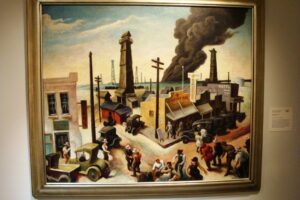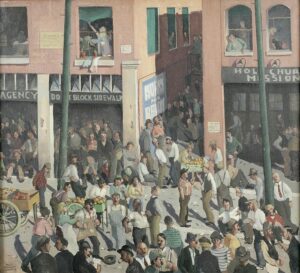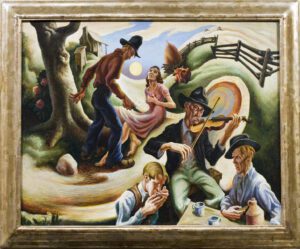American Regionalism is a fascinating cultural tapestry, painting a picture of the diverse identities across the United States.
It’s a phenomenon where local color, traditions, and economic conditions shape the unique character of each region.
We’ll explore how these differences influence everything from dialects to dining, and why they’re crucial for understanding the American experience.
jump into the rich regional distinctions with us, as we uncover the factors that celebrate the individuality of America’s many faces.
History Of American Regionalism
The term American Regionalism encapsulates an art movement that flourished during the 1930s as a response to the rapid urbanization and industrialization that was transforming the country.
Pioneered by artists like Grant Wood, Thomas Hart Benton, and John Steuart Curry, this movement was grounded in the depiction of rural American life, aiming to highlight the local cultures and landscapes that were in danger of being overshadowed by the growth of cities.
These artists sought to create a distinctly American art, one that turned away from European avant-garde styles and focused on scenes of everyday life in the United States.
American Gothic, perhaps the most recognizable piece from this period, embodies the movement’s ethos with its stark portrayal of Midwestern farmers.
The artwork evokes a sense of nostalgia and reflects a yearning for simpler times, a common sentiment during the Great Depression era.
Key Characteristics of American Regionalism:
- Focus on rural American life,
- Emphasis on local culture and tradition,
- Reaction against urbanization and industrialization,
- Narrative style in art featuring common people’s experiences.
Beyond the canvas, regionalism influenced literature and film, further pushing American stories and perspectives to the forefront.
Writers like Willa Cather and John Steinbeck became synonymous with the literary side of regionalism, offering vivid prose that painted the heartland of America in words as compelling as the visual art.
Similarly, films like The Grapes of Wrath provided societal commentary through the medium of storytelling, resonating with audiences across the nation.
What’s crucial in understanding regionalism is recognizing its role as a counter-narrative.
It wasn’t just about capturing the aesthetic of rural life; it was a political statement too, subtly critiquing the consequences of modernity on traditional American values.
This ideological undercurrent adds layers to the movement, making the study of regionalism both an artistic and sociological Try.
Cultural Diversity Across The United States
As we jump into the tapestry of American Regionalism, it’s crucial to recognize the breadth of cultural diversity across the United States.
This movement portrayed a cross-section of American society, presenting a window into the myriad of cultures that stitched the nation together.
Our exploration into this art reveals not just the bucolic landscapes and earnest proletarians but also the vastly different traditions and practices that defined each region.
American Regionalism thrived on the portrayal of the unique aspects of regional cultures.
Artists like Grant Wood became synonymous with depictions of the Midwest, embodying its spirit through works such as American Gothic.
Meanwhile, Thomas Hart Benton captured the undulating energy of the South with his sinuous lines and earthy tones.

- American Gothic,
- Cotton Pickers,
- Baptism in Kansas.
The powerful narratives of American Regionalism were not confined to canvas alone.
In literature, authors harnessed the essence of regional diversity to tell compelling stories.
Willa Cather’s novels painted the stark yet beautiful life on the Great Plains, while John Steinbeck’s narratives unveiled the harsh realities faced by characters in the Californian agricultural belt.
Each literary work served as a monument to the distinct character of its setting and the people inhabiting it.
My Ántonia and The Grapes of Wrath are just tips of the iceberg when it comes to regional influences within American literature.
Our deep-seated connection to these stories underscores the immense diversity presented through the lens of regionalism.
In film, the same principle applied, with directors like John Ford bringing to life the trials and triumphs of destitute families in productions such as The Grapes of Wrath, adapting Steinbeck’s novel to the screen and showcasing regional disparities.
The influences of American Regionalism extended beyond the contours of artwork, literature, and film.
The movement injected a newfound appreciation for the collective patchwork of cultures that composition America’s identity.
Through this lens, we’ve come to understand that Even though the variations in social fabric, there remains an underpinning unity, one that Regionalism has perpetually captured and celebrated.
Linguistic Variations In Different Regions
The diverse tapestry of the United States is vividly reflected in the regional accents and dialects that characterize its people.
As custodians of an intricate cultural mosaic, we observe that American Regionalism extends far beyond the canvas to include the unique linguistic quirks that contribute to America’s multifaceted identity.
Regional vernaculars encapsulate the history, climate, and way of life of a place, painting a vivid portrait of American diversity through the spoken word.
In our exploration of the American heartland, we encounter variations in expressions and vocabulary that define local identities.
For instance, the Southern drawl, with its slow and melodic cadence, conveys the warmth and hospitality of the South.
Similarly, the clipped tones of a New England accent embody the region’s historical connection to its colonial past.
These linguistic traits create an auditory palette as rich and varied as the landscapes they represent.
- Noteworthy accents and dialects in American Regionalism: * The Southern drawl and its variations across states like Texas and Louisiana * The New England accent with roots in colonial English * The distinct Midwestern twang accentuating clarity and straightforwardness.
Artists and literary figures have long been fascinated by these linguistic elements, with authors like Mark Twain incorporating them into their work to bring their characters to life.
Films such as Fargo resonate with audiences in part due to the authenticity of the regional speech portrayed, emphasizing the impact of language on the regionalist narrative.
Let’s jump into the role of linguistics in American Regionalism’s art and literature, where dialects serve not merely as a means of communication but as a storytelling device and cultural marker.
The significance of this element becomes especially pronounced when we appreciate how it infuses regional stories with a palpable sense of place, affirming the indelible link between language and locale within the regionalist ethos.

Cuisine And Food Traditions In Each Region
Delving into the culinary scene, American Regionalism paints a savory portrait of the nation’s diverse food heritage.
In the Deep South, traditions hinge on soul food, a comforting cuisine with robust flavors, using ingredients like okra and sweet potatoes.
The imagery of these dishes, steeped in history, adds depth to regional storytelling and mirrors the cultural richness found in works such as The Color Purple.
Moving to New England, seafood takes center stage with classics like clam chowder and lobster rolls.
These specialties not only fill the pages of novels like Moby Dick but also grace the canvases of artists, symbolizing both the hardships and providence of coastal life.
The Midwest showcases a hearty meat-and-potatoes approach, aligning with the agrarian imagery often depicted in this movement.
Signatures like Chicago deep-dish pizza and Kansas City barbecue are culinary embodiments of the regions they hail from and are frequently celebrated in regional literature and art.
In the Southwest, there’s a blend of Native American and Hispanic influences, with dishes such as tamales and chili con carne highlighting the crossover of cultures and flavors.
This fusion is evident in the nuances of American Regionalist art, where the convergence of traditions creates a distinct, complex narrative.
Consider these iconic foods:
- Creole Gumbo from Louisiana,
- Tex-Mex Fajitas from Texas,
- Green Chile Stew from New Mexico.
Through these palate-pleasing experiences, food serves as a powerful medium, capturing the essence of the local spirit as poignantly as a Grant Wood landscape.
The way regions season their dishes or the particular ingredients they favor are just as telling of their story as the vernacular or local customs showcased in regional literature, film, and art.
Economic Factors Shaping Regional Identities
Economic activities have an undeniable impact on the development of regional characteristics throughout the United States.
Industries not only drive economic prosperity but also shape the social and cultural landscapes of their regions.
For instance, the automotive industry in Detroit significantly influenced the Midwest culture, creating a community that values innovation and manufacturing excellence.
The economic history of a region often dictates its global identity.

Meanwhile, regions like Appalachia, with a history rooted in coal mining, are often associated with blue-collar resilience and a deeply connected community spirit.
These regions have narratives deeply entwined with the work that sustains them, from the wealth of natural resources to the rise of cutting-edge technology.

- Innovation Centers: Cultivate a future-oriented mindset, attracting talent and investment.
- Agricultural Heartlands: Foster a sense of tradition and self-reliance pivotal to pioneering spirits.
- Industrial Powerhouses: Reflect a historical commitment to the manufacturing sector and unionization.
Income disparities and job availability within regions guide not only population trends but also influence the cultural dynamics of an area.
Prosperous regions tend to keep and attract more residents, creating a melting pot of cultures.
In contrast, areas facing economic downturns often experience not only a loss of population but also a cultural shift as residents band together in facing hardship.
Our conversations on American regionalism must account for these economic pivots.
While food and language serve as immediate identifiers of a region’s culture, the underlying economic currents provide a deeper understanding of a region’s narrative.
The strength of these elements combined adds layers to our appreciation of what regional identity truly encompasses.
American Regionalism – Wrap Up
We’ve journeyed through the rich tapestry of American Regionalism, discovering how each area’s unique flavors and economic backdrop contribute to its identity.
It’s clear that the stories of our regions are told not just through words but through the hearty soul food of the South, the seafood delights of New England, and the innovative spirit of the West Coast.
As we’ve seen, these cultural expressions are deeply intertwined with the economic forces that shape our communities.
The result is a vibrant, ever-evolving mosaic that is as diverse as it is unified in its complexity.
Embracing this diversity, we gain a more nuanced appreciation of what it means to be part of the American narrative.
Frequently Asked Questions
What Is The Main Focus Of The Article?
The article primarily explores American Regionalism, emphasizing the cultural diversity and culinary traditions that characterize different regions in the United States.
How Does Food Contribute To Regional Storytelling?
Food reflects the cultural richness and history of each region, acting as a powerful medium that captures the essence of the area’s heritage and its people’s way of life.
What Are Some Regional Food Traditions Mentioned In The Article?
The article highlights soul food from the Deep South, seafood dishes from New England, the meat-and-potatoes approach of the Midwest, and the blend of Native American and Hispanic influences in Southwest cuisine.
How Do Economic Factors Influence Regional Identities In The Us?
Economic factors, such as dominant industries, shape the cultural and social landscapes of regions.
They influence job availability, income levels, and thus population trends, which together guide the evolution of a region’s culture.
Can You Give Examples Of How Industries Have Shaped Regional Cultures?
The automotive industry in Detroit has been significant in shaping Midwest culture, and the tech industry in California has greatly influenced perceptions of innovation and modernity in that region.
Why Is Understanding A Region’s Economic Background Important?
Understanding the economic background provides deeper insight into a region’s narrative, explaining its social and cultural dynamics beyond the immediate cultural identifiers like food and language.
What Conclusion Does The Article Reach About American Regionalism?
The article concludes that while food and language are critical markers of a region’s culture, a comprehensive understanding of a region’s economic factors offers a richer appreciation of its unique identity and place within the broader story of American Regionalism.


